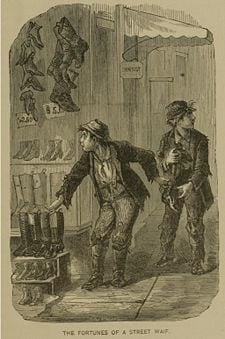Theft
In criminal law, theft (also known as stealing) is the illegal taking of another person's property without that person's freely-given consent. As a term, it is used as shorthand for all major crimes against property, encompassing offenses such as burglary, larceny, looting, robbery, mugging, trespassing, shoplifting, and intrusion In some jurisdictions, theft is considered to be synonymous with larceny; in others, theft has replaced larceny.
The elimination of theft, as with other crimes, is not to be achieved by stricter laws, more effective law enforcement or harsher punishments, but rather in changes within individual human beings and in their relationships to each other and society. When everyone has the opportunity to live a life that is satisfying emotionally and financially and feels that they are part of one harmonious family of humankind, resorting to acts of theft will no longer be attractive or necessary.
Terminology
Theft originates with the Lithuanian tupeti meaning to crouch down.[1] The word "rob" came via French from Late Latin words (deraubare) of Germanic origin, from Common Germanic raub = "clothes," as in old times (before modern cheap mechanized mass production of clothes) one main target of robbers was often the victim's clothes. Someone who carries out an act of or makes a career of theft is known as a "thief" or alternatively a "robber."
Theft can be distinguished from embezzlement, fraud and criminal conversion. Theft is an outright taking of another person's property whereas these other three crimes all involve some type of deception.
Types
Theft can take many forms including burglary, larceny, mugging and robbery. These differ in terms of force and tactics used to appropriate another person's possessions.
The actus reus of theft is usually defined as an unauthorized taking, keeping, or using of another's property which must be accompanied by a mens rea of dishonesty and/or the intent to permanently deprive the owner or the person with rightful possession of that property or its use.
For example, if X goes to a restaurant and, by mistake, takes Y's scarf instead of her own, she has physically deprived Y of the use of the property (which is the actus reus) but the mistake prevents X from forming the mens rea (because she believes that she is the owner, she is not dishonest, and does not intend to deprive the "owner" of it) so no crime has been committed at this point. However, if she realizes the mistake when she reaches home and could return the scarf to Y yet she dishonestly keeps it, she has now stolen the scarf. Note that there may be civil liability for the torts of trespass to chattels or conversion in either eventuality.
Burglary
Burglary is a crime related to theft. It typically involves breaking into a house, outbuilding (such as a shed, stable, or garage), business, school, place of worship, boat, aircraft, railcar or motor vehicle with an intent to commit a theft or felony. To carry out a burglary is to burgle (British English, a word coined by J. R. R. Tolkien in his 1937 novel The Hobbit as a back-formation of the word burglar, which was then adopted in popular speech) or burglarize (American English).
The original common law definition of "burglary" consisted of six specific elements: breaking and entering the dwelling of another during the night with the intention to commit a felony therein:
- Breaking
The first element, "breaking," required at least a minimal application of force. The opening of an unlocked door was sufficient, but if a person entered a house through an already open door or window, there was no "breaking" and therefore no burglary, even if all other elements were present. However, if a person were to enter the house through an open door, and were then to open a closed door leading to another room in the house, that would qualify as "breaking" into that room.
An exception to this rule applies where a person who had permission to enter the house did so at a time when they were not supposed to, or procured this permission by fraud or by threat. Under modern statutes, many jurisdictions have abandoned this element, now merely requiring entry.
- Entering
The second element, "entry," required that the person enter the house with some part of their body, even if only for a moment, or that the person insert a tool into the house for the purpose of committing the requisite felony. For example, firing a bullet through a closed window into someone's house with the intent to injure that person was sufficient to constitute both a breaking and an entry. Entry continues to be a requisite element of burglary in all jurisdictions.
- Dwelling
The third element required that the crime be committed against a "dwelling"—a place where another person regularly slept (even if the structure was also used as a business, or was temporarily abandoned at the time). This requirement has also been largely abandoned under modern statutes, which now permit a burglary conviction to be based on the entry into almost any structure, and sometimes even entry to fenced yards and to automobiles.
- Of another
The fourth element required that the dwelling be that "of another" person. A person could not burglarize their own dwelling, although a landlord could be found to have burglarized the dwelling of his tenant, even though the landlord was the owner of the property itself.
- Nighttime
The fifth element required that the burglary had to be committed at "night," which was defined under the common law as the time when the person's face could not readily be distinguished under the natural light. Laws in many jurisdictions continue to impose much harsher penalties for burglaries committed or attempted at night, or upon an occupied residence.
- Intent to commit a felony
Finally, the sixth element required "intent to commit a felony therein." This intent had to exist at the time of the breaking and entering, even if the felony (murder, rape, larceny or vandalism, for example) was never carried out. If a person broke into a home and, once inside, decided to commit a felony, this would not constitute a burglary. The intent to commit a crime remains an element of all burglary laws, but some jurisdictions have expanded the list of requisite crimes beyond felonies to include any theft, even if it is a misdemeanor.
To a greater or lesser extent, these elements have been replaced in the various common law countries. In most jurisdictions it no longer need be in the night time and the intent to commit any felony can suffice.
Burglary excludes lawful break-ins of property, such as those necessary for rescue of persons or animals, extinguish a fire, lawful searches and seizures by police, confiscation of visible contraband, effecting a lawful arrest or eviction of a tenant who has failed to meet obligations. It also presumes that the break-in is contrary to the desire of the property owner; a locksmith who picks or destroys a lock to allow entry of the rightful owner or tenant is not a burglar. Furthermore, in the case of a life-threatening situation (such as a storm or fire), someone who takes shelter in another's property is not a burglar.
Larceny
Larceny is the wrongful taking of another's goods with the intent of keeping them.
Larceny under common law is never applied to real property (land), or services. However, in the U.S., the Model Penal Code (MPC) states that services can be the subject of theft. Wild animals (ferae naturae) are deemed to not be the property of the owner of whatever land they are found on, so takings of wild animals are also not subject to larceny.
One can only "steal" one's own property when another has a better right to possession at the relevant time. Larceny is a crime of possession, not ownership. Thus, if a vehicle is under the possession of a mechanic, and the owner takes the vehicle, he could be guilty of larceny.
The intent required is that one intended to deprive the possessor of the property "permanently." Courts have held that "permanence" is not simply keeping forever; it can include the intent to deprive the possessor of economic significance, even if there are plans to return the property later. Although the mens rea of larceny is the intent to steal, the focus is on the loss to the possessor, not the gain to the defendant. Thus, even if the thief did not gain in the taking, it could still be classed as larceny if the possessor lost in the process. Further, the mens rea and actus reus must coincide. If one rents a car with intent to return, then decides to keep it, then there is no larceny.
- Larceny by trick or deception occurs when the victim of larceny is tricked by a misrepresentation of fact into giving up possession of property. This should not be confused with false pretenses, where the victim is tricked into giving up title to the property. However in New York State this class of larceny is broken down in statutes into two types.
- Grand larceny is typically defined as larceny of a significant amount of property, in some cases, it can be less. In the U.S., it is often defined as an amount valued at $200 or more. In New York, "grand larceny" refers to amounts of $1,000 or more. Grand larceny is often classified as a felony with the concomitant possibility of a harsher sentence. Sometimes, the crime can be considered serious even for trivial theft. For example, in Virginia, petit larceny (a misdemeanor) occurs when the amount stolen is less than $5, if taken from the person (such as pickpocketing or robbery) or less than $500 if not taken from the person (stealing someone's property).[2] Grand larceny (a felony) occurs for a theft of only $5 or more from a person or more than $500 if not taken from the person.[3]
Robbery
Robbery is the crime of seizing property through violence or intimidation. More precisely, at common law, robbery was defined as taking the property of another, with the intent to permanently deprive the person of that property, by means of force or fear. It should be noted, in common with most legal terms, the precise definition of robbery varies between jurisdictions. Robbery is also when there is forced intimidation placed upon the victim/victims.
Common issues in differentiating robbery from simple theft is the degree of force required and when the force is applied. However, these distinctions vary from jurisdiction to jurisdiction.
The element of force differentiates robbery from embezzlement, larceny, and other types of theft. Piracy (robbery at sea) is a type of robbery. Armed robbery involves the use of a weapon. Aggravated robbery involves the use of a deadly weapon or something that appears to be a deadly weapon. Highway robbery or "mugging" takes place outside and in a public place such as a sidewalk, street, or parking lot. Carjacking is the act of stealing a car from a victim by force.
Informally, robbery may be used to denote other kinds of theft that are not robbery, such as burglary. People returning home and finding their possessions stolen may well exclaim, "We've been robbed!" though actually they have been burgled.
Mugging
Mugging is a type of robbery, in which the perpetrator (the "mugger") accosts the victim in a public place, such as a sidewalk, street or parking lot and demands money and/or valuables through the use of force or fear. The thief will typically threaten to use a weapon such as a gun or knife. Most mugging victims are uninjured or suffer minor injuries.
The term "mugging" gained its current popularity in the United States, with New York City infamously described in the 1970s as "the mugging capital of America." However, the crime is as old as history, and among other things has been known as highway robbery, purse-snatching, or footpadding (which could be surreptitious or violent). In Victorian times the targets were wallets and gold watches. In the U.S., there was a big increase in reported street robberies and handbag snatches from the 1960s onwards as new consumer items became popular. Principal targets became valuable and popular accessories like portable audio devices, cameras, laptop computers, mobile phones, and other items that can be quickly and easily resold. Excitement, status, and gang initiation are undoubtedly important motives too.
In larger United States cities and in the United Kingdom, the news media report and cover muggings as a crime trend, and some observers blamed the news media for a moral panic in England from the early 1970s at a time when “newspaper reporting of mugging(s) emerged and became increasingly sensational.”[5] Nonetheless, as recorded crime statistics, insurance claims, and national crime surveys show, street robberies remained a growing problem until they peaked at about the turn of the millennium.
Bank robbery
Bank robbery is the crime of robbing a bank. It may also be called a "bank heist" especially in the United States. It is usually accomplished by a solitary criminal who brandishes a firearm at a teller and demands money, either orally or through a written note. The most dangerous type of bank robbery is a "takeover robbery" in which several heavily armed (and armored) gang members threaten the lives of everyone present in the bank. A bank robbery can also take place during off hours when thieves try to break into the vault and steal the money.
Due to modern security measures like security cameras, armed security guards, silent alarms, exploding dye packs and SWAT teams, bank robberies are now much more difficult. Few criminals are able to make a successful living out of bank robbery over the long term since each attempt increases the probability that they will be identified and caught. Today most organized crime groups tend to make their money by other means, such as drug trafficking, gambling, loan sharking, identity theft or online scamming and phishing.
A further factor making bank robbery unattractive for criminals in the United States is the severity with which it is prosecuted. Accounts at all U.S. banks are insured by the Federal Deposit Insurance Corporation, a corporation of the federal government, bringing bank robbery under federal jurisdiction and involving the Federal Bureau of Investigation. Federal sentencing guidelines for bank robbery mandate long prison terms, which are usually further enhanced by the use or carrying of loaded firearms, prior criminal convictions and the absence of parole from the federal prison system. As with any type of robbery, the fact that bank robbery is also inherently a violent crime typically causes corrections administrators to place imprisoned bank robbers in harsher high-security institutions.
Nevertheless, bank robberies are still fairly common and are indeed successful, although eventually many bank robbers are found and arrested.
Penalties
Penalties for theft vary on the total worth of the goods stolen and on the force used to take said goods. Repeat offenders who continue to steal may become subject to life imprisonment in certain states.[6]
In many of the United States muggings or street robberies are prosecuted as felonies with penalties of victim restitution and incarceration, with lifetime incarceration, without parole, for the third felony conviction pursuant to the three strikes laws.
Notes
- ↑ "Thief," Online Etymology Dictionary. Retrieved September 17, 2018.
- ↑ § 18.2-96. Petit larceny defined Code of Virginia. Retrieved September 17, 2018.
- ↑ § 18.2-95. Grand larceny defined Code of Virginia. Retrieved September 17, 2018.
- ↑ J. M. W. Silver, Sketches of Japanese Manners and Customs. Available online from Project Gutenberg. Retrieved September 17, 2018.
- ↑ Frankie Y. Bailey and Donna C. Hale, Popular Culture, Crime, and Justice (Wadsworth Pub Co, 1997, ISBN 978-0534519759).
- ↑ See Rummel v. Estelle, (upholding life sentence for fraudulent use of a credit card to obtain $80 worth of goods or services, passing a forged check in the amount of $28.36, and obtaining $120.75 by false pretenses) and Lockyer v. Andrade, (upholding sentence of 50 years to life for stealing videotapes on two separate occasions).
ReferencesISBN links support NWE through referral fees
- Allen, Michael. Textbook on Criminal Law. Oxford University Press, 2005. ISBN 0199279187
- Bailey, Frankie Y., and Donna C. Hale. Popular Culture, Crime, and Justice. Wadsworth Pub Co, 1997. ISBN 978-0534519759
- Doherty, Paul. The Great Crown Jewels Robbery of 1303: The Extraordinary Story of the First Big Bank Raid in History. Carroll & Graf, 2005. ISBN 0786716649
- Griew, Edward. Theft Acts 1968 & 1978. Sweet & Maxwell, 1974. ISBN 0421199601
- Justinian. The Digest of Roman Law: Theft, Rapine, Damage, and Insult. Penguin Classics, 1979. ISBN 0140443436
- Maniscalco, Fabio. Theft of Art. (in Italian) Naples: Massa, 2000. ISBN 8887835004
- Newton, Michael. The Encyclopedia of Robberies, Heists, and Capers. Checkmark Books, 2002. ISBN 0816044899
- Ormerod, David. Smith and Hogan Criminal Law. London: LexisNexis, 2005. ISBN 0406977305
- Smith, J. C. Law of Theft. London: LexisNexis, 1997. ISBN 0406895457
- Swierczynski, Duane. This Here's a Stick-Up: The Big Bad Book of American Bank Robbery. Alpha, 2002. ISBN 0028643445
Credits
New World Encyclopedia writers and editors rewrote and completed the Wikipedia article in accordance with New World Encyclopedia standards. This article abides by terms of the Creative Commons CC-by-sa 3.0 License (CC-by-sa), which may be used and disseminated with proper attribution. Credit is due under the terms of this license that can reference both the New World Encyclopedia contributors and the selfless volunteer contributors of the Wikimedia Foundation. To cite this article click here for a list of acceptable citing formats.The history of earlier contributions by wikipedians is accessible to researchers here:
- Theft history
- Burglary history
- Larceny history
- Robbery history
- Bank_Robbery history
- Mugging_(Robbery) history
- Burglary_(history) history
The history of this article since it was imported to New World Encyclopedia:
Note: Some restrictions may apply to use of individual images which are separately licensed.



